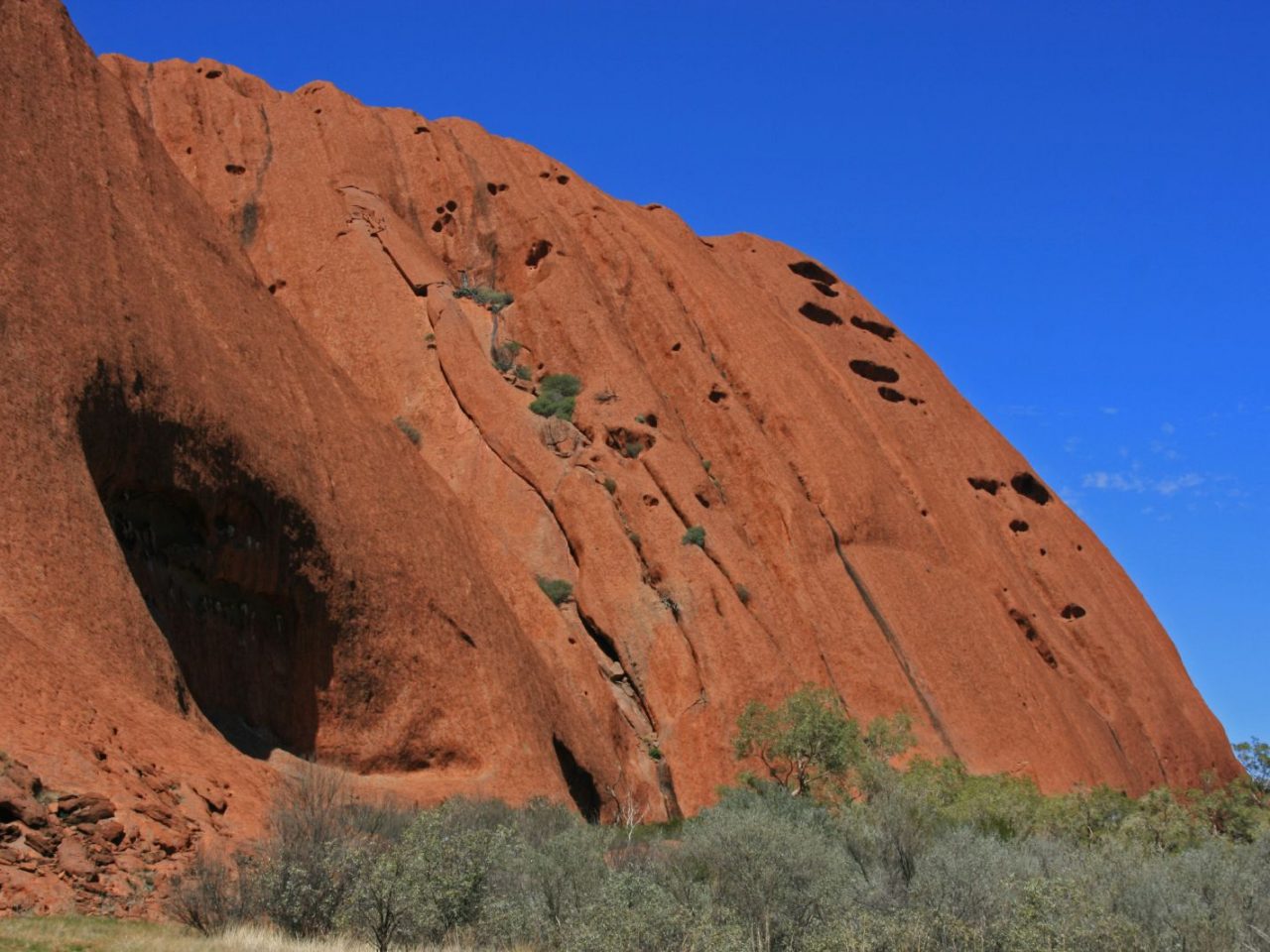
Uluru, Alice Springs, Australia is the largest monolith in the world. Once you enter the Uluṟu-Kata Tjuṯa National Park, in Red Centre, it doesn’t matter where you look, your eyes will surely be captured by Uluru. This giant red-colored rock breaks the flat horizon, making it impossible to ignore. Once you get closer to the giant rock, it completely fills your visual field and your car’s windscreen. Even if you tried to look away, you couldn’t. But believe me, you won’t want to look away.

Also known as Ayers Rock, Uluru is made of sandstone. Although sandstone is usually grey, Uluru turned its reddish color after a process of oxidation.
Once you look at Uluru up close, you will notice it is rich in details and textures. Walking around the base of the rock, you can see numerous furrows decorating its surface, where torrential waterfalls flow when it rains. And it rains quite often. Here and there, you will find caves and crevices, eroded into the rock by water and air. These caves eventually turned into Aboriginal creation tales. It’s another one of nature’s works of art.


The people of Uluru
The Traditional Owners of Uluru go by the name of Aṉangu, and the great rock has just as great cultural meaning to them. Even if at first it appears as irrelevant details, two of the walks illustrate their respect for nature and natural places through paintings and images carved into the rock. The landscape is genuinely sacred for them since they believe it is still inhabited by ancestral creator beings.


The Mutitjulu walk
The Mutitjulu Walk takes you through an area that has been inhabited by Aboriginal people for about 10 thousand years and finally to the Mutitjulu Waterhole. Various features and marks along this walk are said to be the results of great fights waged by ancestral serpent beings. Above all, the tale of Kuniya, the woman python, and Liru, a poisonous snake, is the most commonly told.


The Mala walk
The Mala Walk takes you to some of the places used by the Mala people for Inma, a religious ceremony which required their menfolk to climb to the top of Uluru. In the past, following a route to the top of the rock was a must for tourists. However, getting to the top actually offends the Aṉangu people. No one prohibits you from climbing Uluru, but the Anangu themselves kindly request not to do so. Out of respect, many people have stopped trying.
This spiritual significance makes it hard to balance the needs of the Aṉangu people, and the needs of tourists who visit the rock formation. On one hand, a culture that values and worships their sacred territory. On the other hand, a culture without limits, that seems to worship almost nothing.

Uluru: A Forbidden Wonder
And just as if it wasn’t enough encouragement, let me inform you that photographing in almost half the sacred site is prevented, as it also offends the Aṉangu people. For this reason, you won’t find views of Uluru at sunrise or dawn anywhere, when it glows bright red. Seeing these changes of colors throughout the day makes the visit totally worth it, as you won’t see it anywhere else.


How to get there
Connellan Airport is just a few kilometers away from the town of Yulara, or Ayers Rock Resort.
Planning
However, the only airline that flies to Connellan Airport is Qantas, so keep in mind that, to get reasonable fares, you should book in advance. There are also organized tours around the park, but unfortunately hiring a car at the airport is more expensive. Seriously, book in advance!
Finally, accommodation at Yulara ranges from a campsite to a luxury complex, and the small town has various restaurants and shops, making your experience and stay more pleasant.
Other Nearby Attractions
Kata Tjuta (Olgas)
About 40 km west from Ayers Rock, there’s a group of large, dome-shaped rocks known by the name of Kata Tjuṯa, or the Olgas. These are the second major feature that gives the name to the Uluṟu-Kata Tjuṯa National Park. Some of the peaks are taller than Uluru itself, and they are just as sacred to the Aṉangu people. And just like Uluru, these peaks look spectacular at sunrise and sunset. Spending a day exploring them should definitely be on your bucket list.

If you loved this article or found it useful, don’t forget to share it with your adventurous and travel-hacking friends! If you want more posts like this, follow us on Youtube, Instagram, Pinterest, Twitter or Facebook and subscribe to our newsletter!

